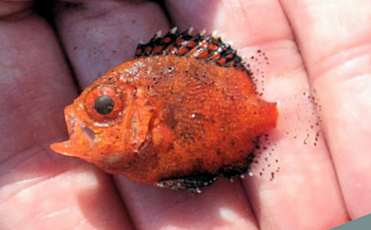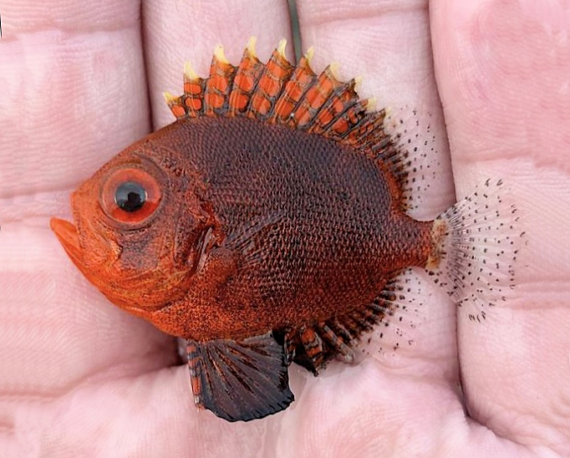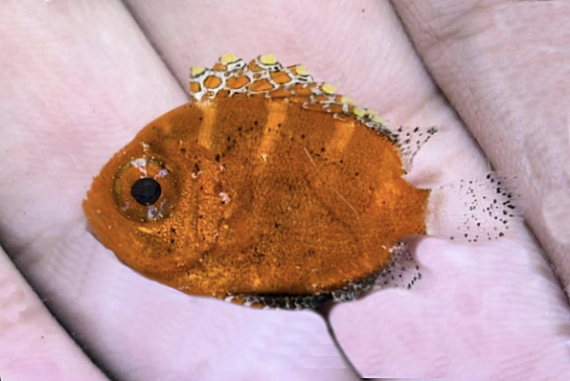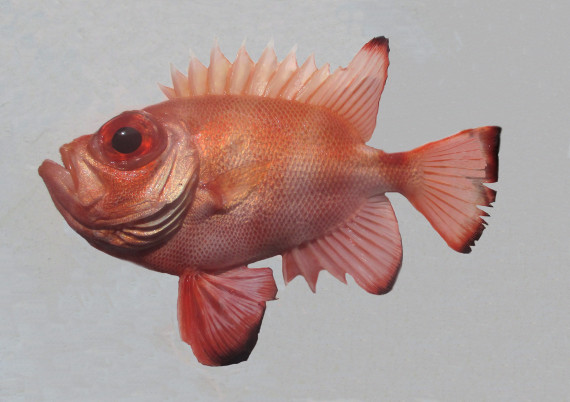Short Bigeye, Pristigenys alta
 Short Bigeye, Pristigenys alta, Juvenile. Fish collected at the Martinque Beach Provincial Park, East Petpeswick, Nova Scotia, August 2015. Length: 4.5 cm (1.8 inches). Photograph courtesy of Ashley Bingham, We Love Nova Scotia, Facebook.
Short Bigeye, Pristigenys alta, Juvenile. Fish collected at the Martinque Beach Provincial Park, East Petpeswick, Nova Scotia, August 2015. Length: 4.5 cm (1.8 inches). Photograph courtesy of Ashley Bingham, We Love Nova Scotia, Facebook.
 Short Bigeye, Pristigenys alta, Juvenile. Fish caught from coastal waters off Long Island, New York, August 2023. Length: 5.4 cm (2.0 inches). Catch, photograph and identification courtesy of Aidan Perkins, Long Island, New York.
Short Bigeye, Pristigenys alta, Juvenile. Fish caught from coastal waters off Long Island, New York, August 2023. Length: 5.4 cm (2.0 inches). Catch, photograph and identification courtesy of Aidan Perkins, Long Island, New York.
 Short Bigeye, Pristigenys alta, Juvenile. Fish caught from coastal waters off Long Island, New York, August 2023. Length: 5.5 cm (2.0 inches). Catch, photograph and identification courtesy of Aidan Perkins, Long Island, New York.
Short Bigeye, Pristigenys alta, Juvenile. Fish caught from coastal waters off Long Island, New York, August 2023. Length: 5.5 cm (2.0 inches). Catch, photograph and identification courtesy of Aidan Perkins, Long Island, New York.
 Short Bigeye, Pristigenys alta. Fish caught from waters of the Florida Middle Grounds, March 2016. Length: 23 cm (9.1 inches). Catch, photograph and identification courtesy of George Brinkman, Guelph, Ontario, Canada.
Short Bigeye, Pristigenys alta. Fish caught from waters of the Florida Middle Grounds, March 2016. Length: 23 cm (9.1 inches). Catch, photograph and identification courtesy of George Brinkman, Guelph, Ontario, Canada.
The Short Bigeye, Pristigenys alta, is a member of the Bigeye or Priacanthidae Family, and is known in Mexico as catalufa de lo alto. Globally, there are four species in the genus Pristigenys, of which two are found in Mexican waters, one in the Atlantic and one in the Pacific Ocean.
The Short Bigeye is characterized by a strongly compressed, distinctively deep oval body that has a depth that is 49% to 53% of standard length. Adults are uniformly dark red on their head, body, and fins. The iris of their eyes is red to silvery. The margins of their anal, caudal, and soft dorsal fins are black and the posterior third of their pelvic fins are black. Juveniles are significantly different with transparent anal, caudal, and second dorsal fins with small black spots (pictured above); their first dorsal fin is black with mid-sized red spots. They have a large upturned mouth with a projecting lower jaw. Their anal fin has 3 spines and 10 rays; their caudal fin is rounded; their dorsal fin is continuous with 10 spines (the longest being in the middle), and 10 to 12 rays; their pelvic fins are broadly fused to the belly and are of moderate length and under the pectoral fin base. Their body is covered with very large rough scales.
The Short Bigeye resides over and within rocky bottoms at depths up to 182 m (600 feet). They reach a maximum of 33 cm (13 inches) in length. They are nocturnal predators with large eyes that prey mainly on smaller fish found around rocky reef areas. Their red to rose coloration makes them invisible in the deep ocean and helps to avoid predation. They normally reside in total darkness and are known to hide under rock ledges. The Short Bigeye is a rare and poorly studied with very limited information available about their lifestyle and behavioral patterns including specific details on age, growth, longevity, movement patterns, diet, habitat use, and reproduction.
The Short Bigeye is a resident of all Mexican waters of the Atlantic Ocean. Their known range extends as far north as Maine, however, the collection photographed above documents a significant range extension.
The Short Bigeye is a straightforward identification due to its wide oval body and strongly upturned mouth; however, adults are very similar to the Popeye Catalufa, Pristigenys serrula, found only in the Pacific Ocean.
From a conservation perspective the Short Bigeye is currently considered to be of Least Concern with stable widely distributed populations. They are considered to be marginal table fare and normally a “catch and release” are only retained only by subsistence fishermen. They are sold commercially for food on a limited basis and marketed as “Red Snapper.” They are also used fairly extensively by the aquarium trade.